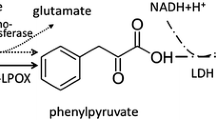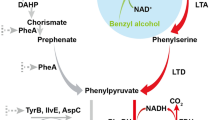Abstract
The bifunctional enzyme chorismate mutase (CM)-prephenate dehydratase (PD), which is encoded by the pheA gene of Escherichia coli, catalyses the two consecutive key steps in phenylalanine biosynthesis. To utilize the enzyme for metabolic engineering of phenylalanine-producing Corynebacterium glutamicum KY10694, the intact gene was cloned on a multicopy vector to yield pEA11. C. glutamicum cells transformed with pEA11 exhibited a more than tenfold increase in CM and PD activities relative to the host cells. Moreover, the level of pheA expression was further elevated a fewfold when cells were starved of phenylalanine, suggesting that the attenuation regulation of pheA expression functions in heterogeneous C. glutanicum. Plasmid pEA11 encoding the wild-type enzyme was mutated to yield pEA22, which specified CM-PD exhibiting almost complete resistance to end-product inhibition. When pEA22 was introduced into KY10694, both the activities of CM and PD were highly maintained throughout the cultivation, thus leading to a 35% increased production (23 g/l) of phenylalanine.
Similar content being viewed by others
References
Backman K, Ptashne M, Gilbert W (1976) Construction of plasmids carrying the cI gene of bacteriophage λ. Proc Natl Acad Sci USA 73:4174–4178
Backman KC, Ramaswamy B (1988) US patent no. 4 753 883
Bradford M(1976) A rapid and sensitive method for quantitation of microgram quantities of protein utilizing the principle of protein-dye binding. Anal Biochem 72:248–254
Choi YJ, Tribe DE (1982) Continuous production of phenylalanine using an Escherichia coli regulatory mutant. Biotechnol Lett 4:223–228
Cotton RGH, Gibson F (1965) The biosynthesis of phenylalanine and tyrosine; enzymes converting chorismic acid into prephenic acid and their relationships to prephenate dehydratase and prephenate dehydrogenase. Biochim Biophys Acta 100:76–88
Dopheide TAA, Crewther P, Davidson BE (1972) Chorismate mutase-prephenate dehydratase from Escherichia coli K-12. Kinetic properties. J Biol Chem 247:4447–4452
Folletti MT, Sinskey AJ (1986) Molecular cloning and nucleotide sequence of the Corynebacterium glutamicum pheA gene. J Bacteriol 167:695–702
Gaertner FH, Ericson MC, DeMoss JA (1970) Catalytic facilitation in vitro by two multienzyme complexes from Neurospora crassa. J Biol Chem 245:595–600
Garner C, Herrmann KM (1983) Biosynthesis of phenylalanine. In: Herrmann KM, Somerville RL (eds) Amino acids: biosynthesis and genetic regulation. Addison-Wesley, Reading, Mass., pp 323–338
Gavini N, Davidson BE (199) The pheR gene of Escherichia coli encodes tRNAPhe, not a repressor protein. J Biol Chem 265:21 527–21 531
Gavini N, Davidson BE (1990) Theulation of pheA expression by the pheR product on in Escherichia coli is mediated through attenuation of transcription. J Biol Chem 266:7750–7753
Gething MJ, Davidson BE (1978) Chorismate mutase/prephenate dehydratase from Escherichia coli K12. Binding studies with the allosteric effector phenylalanine. Eur J Biochem 86:165–174
Gowrishankar J, Pittard J (1982) Molecular cloning of pheR in Escherichia coli K-12. J Bacteriol 152:1–6
Gynheung A, Friesen JD (1979) Plasmid vehicles for direct cloning of Escherichia coli promoters. J Bacteriol 140:400–407
Hagino H, Nakayama K (1974) l-Phenylalanine production by analog-resistantmutants of Corynebacterium glutamicum. Agric Biol Chem 38:157–161
Hwang SO, Gil GH, Cho YJ, Kang KR, Lee JH, Bae JC (1985) The fermentation process for l-phenylalanine production using an auxotrophic regulatory mutants of Escherichia coli. Appl Microbiol Biotechnol 22:108–113
Ikeda M, Katsumata R (1992) Metabolic engineering to produce tyrosine or phenylalanine in a tryptophan-producing Corynebacterium glutamicum strain. Appl Environ Microbiol 58:781–785
Ito H, Sato K, Matsui K, Sano K, Enei H, Hirose Y (1990) Molecular breeding of a Brevibacterium lactofermentum l-phenylalanine producer using a cloned prephenate dehydratase gene. Appl Microbiol Biotechnol 33:190–195
Katsumata R, Ozaki A, Oka T, Furuya A (1984) Protoplast transformation of glutamate-producing bacteria with plasmid DNA. J Bacteriol 159:306–311
Katsumata R, Mizukami T, Ozaki A, Kikuchi Y, Kino K, Oka T, Furuya A (1987) Gene cloning in glutamic acid bacteria: the system and its applications. In: Neijssel OM, van der Meer RR, Luyben KChAM eds Proceedings of the 4th European Congress of Biotechnology, Amsterdam, 14–19 June 1987, vol 4. pp 767–776
Maniatis T, Fritsch EF, Sambrook J (1982) Molecular cloning: a laboratory manual. Cold Spring Harbor Laboratory, Cold Spring Harbor, N. Y.
McEvoy JJ, Joyce A (1974) Production of l-phenylalanine by dl-phenylalanine hydroxamate-resistant Tyr− mutants of Bacillus subtilis. Mol Cell Biochem 4:191–195
Nelms J, Edwards RM, Warwick J, Fotheringham I (1992) Novel mutations in the pheA gene of Escherichia coli K-12 which result in highly feedback inhibition-resistant variants of chorismate mutase/prephenate dehydratase. Appl Environ Microbiol 58:2592–2598
Ozaki A, Katsumata R, Oka T, Furuya A (1984) Functional expression of the genes of Escherichia coli in Gram-positive Corynebacterium glutamicum. Mol Gen Genet 196:175–178
Ozaki A, Katsumata R, Oka T, Furuya A (1985) Cloning of the genes concerned in phenylalanine biosynthesis in Corynebacterium glutamicum and its application to breeding of a phenylalanine producing strain. Agric Biol Chem 49:2925–2930
Saito H, Miura K (1963) Preparation of transforming deoxyribonucleic acid by phenol treatment. Biochem Biophys Acta 72:619–629
Santamaria R, Gil JA, Mesas JM, Martin JF (1984) Characterization of an endogenous plasmid and development of cloning vectors and a transformation system in Brevibacterium lactofermentum. J Gen Microbiol 130:2237–2246
Shiio I, Sugimoto S, Kawamura K (1988) Breeding of phenylalanine-producing Brevibacterium flavum strains by removing feedback regulation of both the two key enzymes in its biosynthesis. Agric Biol Chem 52:2247–2253
Tsuchida T, Kubota K, Morinaga Y, Matsui H, Enei H, Yoshinaga F (1987) Production of l-phenylalanine by a mutant of Brevibacterium lactofermentum 2256. Agric Biol Chem 51:2095–2101
Umbarger HE (1978) Amino acid biosynthesis and its regulation. Annu Rev Biochem 47:533–606
Yoshihama M, Higashiro K, Rao EA, Akedo M, Shanabruch WG, Follettie MT, Walker GC, Sinskey AJ (1985) Cloning vector system for Corynebacterium glutamicum. J Bacteriol 162:591–597
Zurawski G, Brown K, Killingly D, Yanofsky C (1978) Nucleotide sequence of the leader region of the phenylalanine operon of Escherichia coli. Proc Natl Acad Sci USA 75:4271–4275
Author information
Authors and Affiliations
Rights and permissions
About this article
Cite this article
Ikeda, M., Ozaki, A. & Katsumata, R. Phenylalanine production by metabolically engineered Corynebacterium glutamicum with the pheA gene of Escherichia coli . Appl Microbiol Biotechnol 39, 318–323 (1993). https://doi.org/10.1007/BF00192085
Received:
Accepted:
Issue Date:
DOI: https://doi.org/10.1007/BF00192085




